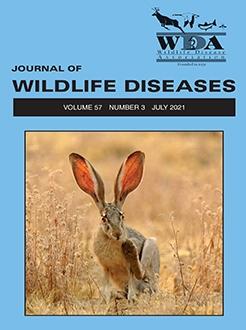Erysipelothrix rhusiopathiae, the causative agent of the disease erysipelas, is a gram-positive bacillus, and an opportunistic pathogen in diverse species of animals. In New Zealand, E. rhusiopathiae has killed endangered birds on offshore islands, including Kākāpō (Strigops habroptilus), Takahē (Porphyrio hochstetteri), and Kiwi (Apteryx spp.). The source of infection is uncertain, and the prevalence of E. rhusiopathiae among wild birds is currently unknown. During October 2018 to December 2018, we surveyed dead and live seabirds that visit two of New Zealand's offshore islands used for Kākāpō conservation with the goal of determining the prevalence of E. rhusiopathiae. Bone marrow from dead birds was cultivated on selective agar, and organisms cultured were identified using matrix-assisted laser desorption/ionization with time-of-flight mass spectrometry. The prevalence of E. rhusiopathiae was calculated in different species for each island. We surveyed live birds using PCR with Erysipelothrix spp.–specific primers on blood samples. The prevalence of E. rhusiopathiae in dead seabirds on Whenua Hou and Te Hauturu-o-Toi was 3.4% (3/86) and 11.4% (5/44), respectively. On Whenua Hou, E. rhusiopathiae was detected in Sooty Shearwaters (Puffinus griseus; 5.9%, 2/34) and Mottled Petrels (Pterodroma inexpectata; 2.7%, 1/36) while it was detected only in Cook's Petrels (Pterodroma cookie; 13.5%, 5/37) on Te Hauturu-o-Toi. Blood samples were collected from two seabird species; only one of 50 Mottled Petrels (2.0%) was positive for the presence of Erysipelothrix spp. Our findings confirm that burrowing seabirds are possible reservoirs of E. rhusiopathiae on both islands studied and may be the source of spillover to other species on the island. The differences in observed prevalence suggest the species composition of the reservoir of E. rhusiopathiae may vary geographically.
How to translate text using browser tools
5 July 2021
SEABIRDS AS POSSIBLE RESERVOIRS OF ERYSIPELOTHRIX RHUSIOPATHIAE ON ISLANDS USED FOR CONSERVATION TRANSLOCATIONS IN NEW ZEALAND
Manjula Jayasinghe,
Anne Midwinter,
Wendi Roe,
Emilie Vallee,
Charlotte Bolwell,
Brett Gartrell
ACCESS THE FULL ARTICLE

Journal of Wildlife Diseases
Vol. 57 • No. 3
July 2021
Vol. 57 • No. 3
July 2021
Codfish Island
Cook's Petrel
erysipelas
Erysipelothrix rhusiopathiae
Little Barrier Island
Mottled Petrel
seabirds




